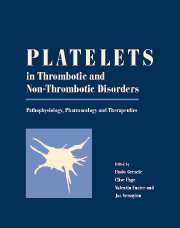Book contents
- Frontmatter
- Contents
- List of contributors
- Editors' preface
- PART I PHYSIOLOGY
- PART II METHODOLOGY
- PART III PATHOLOGY
- 34 Hereditary thrombocytopenias
- 35 Thrombocytopenias due to bone marrow disorders
- 36 Immune-mediated thrombocytopenia
- 37 Thrombocytopenia in childhood
- 38 Alloimmune thrombocytopenia
- 39 Drug-induced and drug-dependent immune thrombocytopenias
- 40 Thrombotic thrombocytopenic purpura and hemolytic uremic syndrome
- 41 Thrombocytosis and thrombocythemia
- 42 Platelet adhesive protein defect disorders
- 43 Congenital disorders of platelet secretion
- 44 Congenital platelet signal transduction defects
- 45 Acquired platelet function defects
- 46 Platelet storage and transfusion
- 47 Pathophysiology of arterial thrombosis
- 48 Platelets and atherosclerosis
- 49 Platelet involvement in venous thrombosis and pulmonary embolism
- 50 Gene regulation of platelet function
- 51 Platelets and bacterial infections
- 52 Interactions of viruses and platelets and the inactivation of viruses in platelet concentrates prepared for transfusion
- 53 Platelets and parasites
- 54 Platelets and tumours
- 55 Platelets and renal diseases
- 56 Platelets and allergic diseases
- 57 Platelet interactions with other cells related to inflammatory diseases
- 58 Platelets and the preimplantation stage of embryo development
- 59 Platelets in psychiatric and neurological disorders
- 60 Platelets in inflammatory bowel disease
- PART IV PHARMOLOGY
- PART V THERAPY
- Afterword: Platelets: a personal story
- Index
- Plate section
43 - Congenital disorders of platelet secretion
from PART III - PATHOLOGY
Published online by Cambridge University Press: 10 May 2010
- Frontmatter
- Contents
- List of contributors
- Editors' preface
- PART I PHYSIOLOGY
- PART II METHODOLOGY
- PART III PATHOLOGY
- 34 Hereditary thrombocytopenias
- 35 Thrombocytopenias due to bone marrow disorders
- 36 Immune-mediated thrombocytopenia
- 37 Thrombocytopenia in childhood
- 38 Alloimmune thrombocytopenia
- 39 Drug-induced and drug-dependent immune thrombocytopenias
- 40 Thrombotic thrombocytopenic purpura and hemolytic uremic syndrome
- 41 Thrombocytosis and thrombocythemia
- 42 Platelet adhesive protein defect disorders
- 43 Congenital disorders of platelet secretion
- 44 Congenital platelet signal transduction defects
- 45 Acquired platelet function defects
- 46 Platelet storage and transfusion
- 47 Pathophysiology of arterial thrombosis
- 48 Platelets and atherosclerosis
- 49 Platelet involvement in venous thrombosis and pulmonary embolism
- 50 Gene regulation of platelet function
- 51 Platelets and bacterial infections
- 52 Interactions of viruses and platelets and the inactivation of viruses in platelet concentrates prepared for transfusion
- 53 Platelets and parasites
- 54 Platelets and tumours
- 55 Platelets and renal diseases
- 56 Platelets and allergic diseases
- 57 Platelet interactions with other cells related to inflammatory diseases
- 58 Platelets and the preimplantation stage of embryo development
- 59 Platelets in psychiatric and neurological disorders
- 60 Platelets in inflammatory bowel disease
- PART IV PHARMOLOGY
- PART V THERAPY
- Afterword: Platelets: a personal story
- Index
- Plate section
Summary
A brief introduction on platelet secretion (see Fig. 43.1)
The essential role played by platelets in hemostasis, thrombosis and vascular remodelling is, to a large extent, mediated by effector molecules that they secrete at sites of vascular injury. These molecules are contained in the platelet dense (or δ-) and α-granules. Dense granules are small organelles (200–300 nm in diameter) that are dense to electrons in osmium-stained platelets. They mostly contain small molecules, such as nucleotides, serotonin, catecholamines, Ca2+, Mg2+ and pyrophosphate. More recent studies have demonstrated the presence of Pselectin, granulophysin, glycoprotein (GP) Ib and GPIIb/IIIa bound to their membrane. Alpha granules, at variance with -granules, are moderately electron-dense and have a diameter of about 200–500 nm. The most numerous of the platelet storage organelles, they contain membrane-bound proteins (GPIb/IX/V, GPIIb/IIIa, Pselectin, GPIV, osteonectin, PECAM1, GMP33, CD9) and are the storage site for proteins which are synthesized in the megakaryocytes (von Willebrand factor, thrombospondin, fibronectin, coagulation factor V, platelet-derived growth factor and other growth factors), or acquired from plasma either by receptor-mediated endocytosis (e.g., fibrinogen) or by fluid-phase pynocytosis (e.g., albumin and immunoglobulin G).
While δ-granules function primarily for the amplification of platelet activation through the secretion of platelet agonists such as serotonin and adenosine diphosphate (ADP), α- granules enhance the adhesive process, promote cell–cell interactions and stimulate vascular repair.
- Type
- Chapter
- Information
- Platelets in Thrombotic and Non-Thrombotic DisordersPathophysiology, Pharmacology and Therapeutics, pp. 655 - 673Publisher: Cambridge University PressPrint publication year: 2002
- 7
- Cited by

